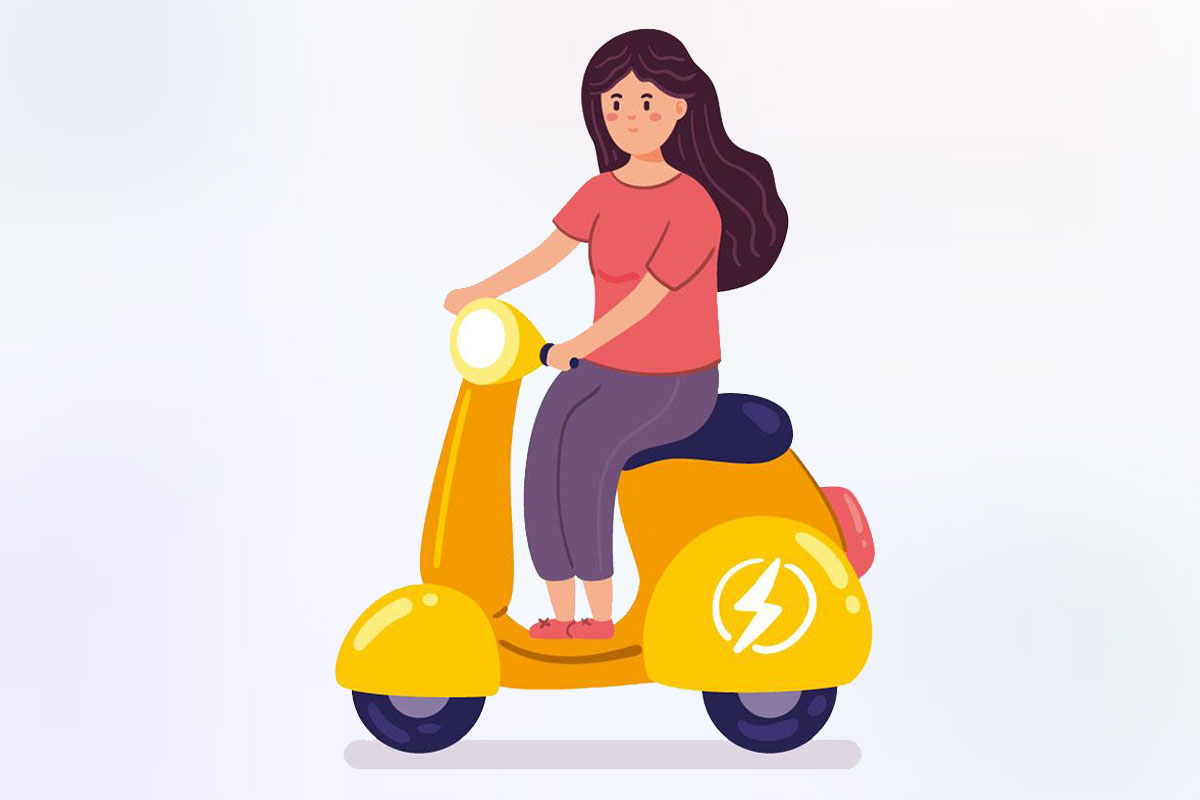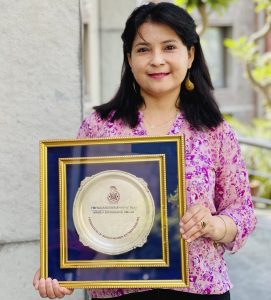
Every morning, Samjhana Majhi travels from Lokanthali to Naxal. Reaching there she picks up the delivery bag and rides her cycle to make food deliveries across the Kathmandu valley. Some days she rides her cycle from Gaushala to the Baneshwor area while other days she is seen going around in New Road and Thamel area. But she does all this carrying the bag on her shoulders and peddling relentlessly to reach places.
This 25-year-old food delivery rider has been working in Foodmandu for the past six months and that is her everyday routine. Recently, she came across a new initiative that could help her get an electric scooter and if everything goes well, Majhi is excited to make her deliveries on a brand new scooter, that she will own.
The initiative she believes can help riders like her to achieve their daily target and commute easier, and foster a greener future.
What is the initiative about?
The initiative in question is being introduced under the Women for a Greener Future project that aims to help women in Nepal, feel empowered with the ownership of electric vehicles and also by helping them secure jobs in the logistics industry.
The initiative has been conceptualised by Aloi, a fintech company, working to empower women for a greener future. Explaining the initiative, Project Lead Birat Singh Thakuri says, “Aloi will help women with access to loans, which they can use for anything ranging from training on how to ride, obtaining driving licenses as well as help them purchase the electric scooters in easily with more payment options.”
The project is also partially funded by the National Geographic Society.
Thakuri further says the initiative aims to change the current scenario in various aspects. The overall objective is that they want to see more women riders using electric vehicles that they own on the road.
“We are working on the aspect of women empowerment, we are increasing the number of electric vehicles on the road and taking a step towards a more environment-friendly commuting ecosystem,” says Thakuri.

Connecting women to the workforce, especially the logistics industry that sees a heavy number of male riders, is another target of the company, he says.
“These riders are the ones with the most commuting need. And the majority are males using two-wheelers that use petrol, and women riders, cycle riders as well as those using electric scooters are in the minority.”
Priority will be given to women who are seeking jobs in the logistics industry, but women who already have jobs and just want to purchase the scooter, have the job and petrol scooter but want to switch to EVs and those who just want to own a scooter will also be considered within the project.
To bring this ambitious project into the field, Aloi is partnering with banks for easy collateral-free loans, logistics companies for workforce employment, and electric scooter firms for discounted scooters. They are also collaborating with other stakeholders to engage women through informative sessions, making its ambitious project a reality. “We believe that this project is a win-win for everyone,” he claims.
“It has been just over a month that we have been flowing the information about the project, and we are getting positive responses, both from the women and the stakeholders that we are partnering with,” he assures.
A key highlight of this project is that it will bring all the stakeholders under Aloi’s in-house app or platform that enables seamless recording, tracking, and monitoring of the transactions assuring that the loans are being used for the disclosed purpose only. And women who signup for the initiative will be saving a portion of their salary to pay the EMIs, where the banking institutions will facilitate the monthly or regular transactions, creating a more stable payment ecosystem.
The project is currently in the pilot phase but is expected to take full-fledged shape within July itself and it hopes to onboard over 100 women in a year. Will it achieve the target and build a greener future?
Positive steps towards change
The initiative has been hearing positive responses from its stakeholders. Banks are ready to give easy loans to women and help them purchase, and logistic companies they have tied up are encouraging women to apply and join the workforce while also asking existing female employees to switch to EVs. And e-scooter companies are also naturally happy about the expected transactions.
The added notion of women empowerment and environment-friendly initiative has been encouraging the stakeholders too to be a part of the greener future.
But as the first phase of the initiative is going live, the question remains will the females be open to joining the present male-dominated sector? First, on the number itself, management of Bhoj, Foodmandu, Khaanpin, and Upaya all share they are positive to welcome the new female workforce, as they unanimously voice that they have always kept the doors open to anyone who walks in, eager to work for them.

The nature of the sector also encourages more riders, they say. According to Isha Balla, co-founder of Khaanpin, “The sector is very fickle in terms of workforce, as retention of the same rider has been a bit difficult. So, the increasing numbers will surely help.”
Bhoj’s co-founder Niket Agrawal also says it will not create saturation in the workforce so the women are welcome.
In the current scenario, women riders are in the minority. Bhoj has over 250 riders but only five are women, whereas Khaanpin has some 40 riders but two active women riders. Upaya also has a similar ratio with three or four female riders at a time and Foodmandu has five riders active in Kathmandu at the moment.
Given the tipped scale, encouraging women to join the workspace has been a struggle. But the logistic partners are positive that the benefits including the ownership and the freedom will encourage more women to be a part of this.
As per Melissa Rajopadhyaya, director of people operations manager for Upaya, to change the scenario what females need is the right motivation and inspiration. “If we take the example of tempo operators, the sector also saw majorly males as drivers. But today the sector has been female-oriented. It can be a great case study to see how we can encourage females to be more active and lead, free of biases and hesitation.”
Aloi, which has helped females get easy loans to purchase safa tempos and batteries for vehicles, is also positive to see the same result replicated in its new project too.
Riders like Majhi are also positive, “I am very positive about switching to an electric scooter. It is economic and is good for the environment too.” In the same office, 23-year-old Riti Subba, who works as a brand marketing executive, is also interested in switching to an electric scooter. “I have gone back and forth about it. The scooter I am using is more than seven years old now. And, with some deliberations, I think can switch to EV as well.”
But Subba does have some concerns over the immediate switch.
Reservations to address
When it comes to EVs, Nepal is still new in the game. Though lucrative, there is a lot that is still in the experimental phase and it has not garnered the confidence of everybody. Naturally, that is the biggest reservation everybody is having and the education about the EV is the key concern too.
Subba adds here, “The nature of my job demands that I go places and, one of my concerns is of course if the battery would be enough, and where I can charge it when I need it.”
“There is also the fact about how well it would perform in all terrains, especially uphills,” she adds.

Excluding the terrain, Aloi and the logistic companies say they are working on installing charging stations at their office premises and in their network to ease the commute for the riders and address their concerns over charging.
But that is not the only concern. The average range of the cheaper variants of the electric scooters is about 60 to 70 km and their size is smaller than the average petrol scooters too. So, for the delivery riders, how feasible or which model will suit their daily travel needs and accommodate the heavy bag they have to carry with them is still up for debate.
Majhi shares that a few riders she has seen riding the electric scooters already say they are having no problem, and looking at her average travel range, she is positive about switching to EV and delivering more.
And, as per the contract, the logistics companies will only be giving jobs to the riders. So, the research on which EV will suit their riders the best has not topped their concern list.
However, this also means that the females who want to join the workforce or own the scooter will have to bear the finances and EMIs for the process. There is no finance from the management of the logistics companies available as of now though some say they are considering it.
Majhi says, so far, it seems feasible for her to cover the expenses for the scooter. Same for Subba. But for 18-year-old Puspa Sunuwar considering ownership at the moment is not possible.
Sunuwar is in training with Life Project 4 Youth (LP4Y) for six months and only when she starts earning will she be able to consider the purchase, “But I am positive about getting a scooter for myself later.”

























